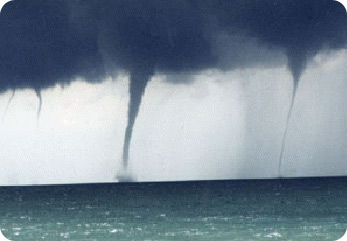170510-spout.jpg

Waterspout Credit: NOAA
Residents of the Florida Keys are on the alert for marine storms at this time of year -- and not just hurricanes. Much smaller storms twist around the island chain, too -- up to several hundred a year. They look like skinny tornadoes -- rope-like funnels that twist across the water for a few minutes.
Water spouts are most common around the Keys, but they’re found in other coastal regions around the country and around the world.
Water spouts begin in much the same way as tornadoes, with warm, moist air rising into the atmosphere and condensing to form clouds. The clouds that give birth to tornadoes top out at 8 or 10 miles -- altitudes where they pick up additional energy from the jet stream and other wind currents.
But the clouds that give birth to water spouts top out at only 3 or 4 miles. So water spouts get much of their twisting motion from air currents at the surface. As the warm air rises, cooler air rushes in to fill the void. In some cases, that creates a spinning effect. The rising air that builds the clouds lifts some water from this vortex, forming a funnel around the spinning column of air -- a water spout.
Because they don’t have the added energy of the high-altitude winds that help power tornadoes, most water spouts are fairly weak -- their winds don’t go over about 50 miles an hour. But a few can get nasty, with peak winds of 150 miles an hour or stronger. Either way, it’s best to do what you should do with all marine storms: get out of the way.

